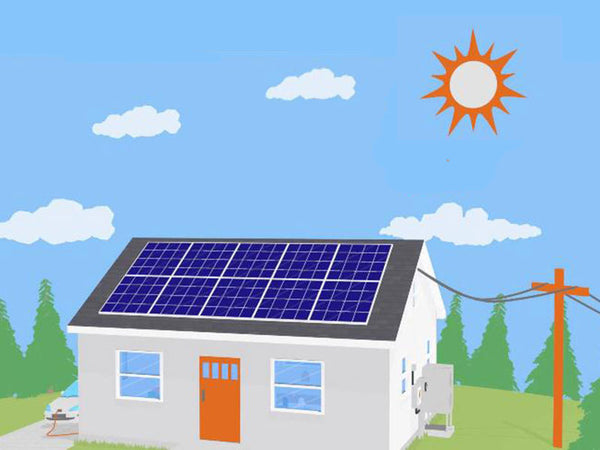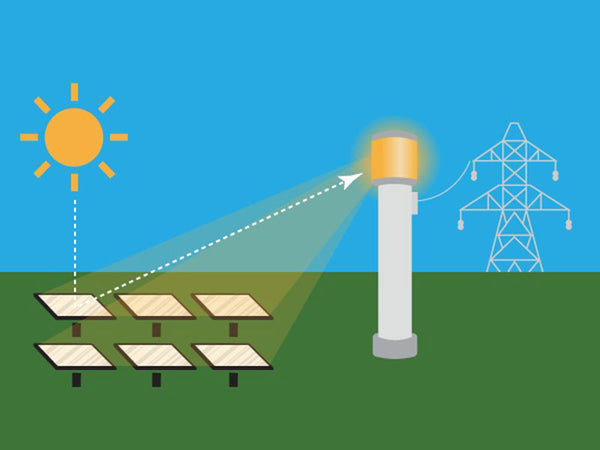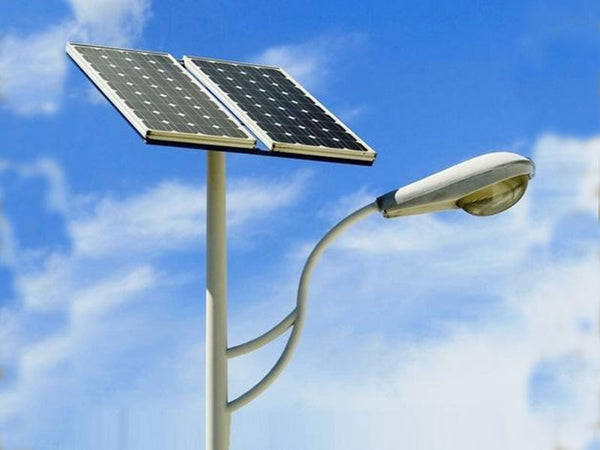
main content:
- 1 How much solar energy is there on the earth?
- 2 Solar thermal utilization?
- 3 What is photovoltaic power generation?
1 How much solar energy is there on the earth?

The sun is the greatest. People sing praises to the sun, and often compare a promising life to the sun, which contrasts with the sun's loveliness. Youth is the sun, shining brightly; the year of not being confused and knowing the destiny is like the sky in the sun; old age is the setting sun, there are residual heat and sunset, these are all the energy of the sun.
The sun is a hot "big balloon", it is composed of 80% hydrogen and 19% helium. The diameter of the sun is about 1.39 million kilometers and its volume is 1.3 million times larger than that of the earth. The mass of the sun is about 2.2×1027 tons, which is more than 300,000 times that of the earth. The sun is undergoing a nuclear fusion reaction (also called a "thermonuclear reaction") from hydrogen to helium, continuously releasing huge amounts of energy. According to the estimation of the nuclear energy rate currently produced by the sun, the stored hydrogen can also sustain the thermonuclear reaction for 60 billion years. The inner core of the sun, that is, the area with a radius of about 14 of the sun, is very dense, 80-100 times the density of water. Although this area only accounts for 15% of the sun's volume, it concentrates 40% of the sun's mass. This inner core is the area of thermonuclear reaction, and the energy produced by it accounts for 90% of the total energy produced by the sun. This inner core area is extremely hot and emits gamma rays. Gamma rays consume energy when passing through colder areas, increase their wavelengths, and become X-rays, ultraviolet rays, and visible light. The outer part of the sun is a photosphere, that is, the surface of the sun that people can see. It is composed of highly ionized gas, and solar radiation into space begins.
How much energy does the earth receive from the sun? The earth is like a drop in the ocean in the space of the solar system. The part of solar radiation energy reaching the earth is only one part of 2.2 billionth of its total radiation, which is about 173 trillion kilowatts, which is equivalent to the calorific value of burning 5 million tons of coal per second. The earth's hydropower, wind power, biomass energy, and part of the ocean energy (such as temperature difference energy, etc.) all come from solar energy, and even fossil energy such as coal, oil, and natural gas is also solar energy stored in ancient times. The solar radiation intensity at the upper boundary of the atmosphere is almost constant, which is called the "solar constant". Due to the reflection and blocking of the atmosphere, when solar radiation reaches the ground, the radiant energy is greatly reduced, leaving about half. Of this half, about 15, about 17 trillion kilowatts are distributed on the land surface. In most areas of the world during the sunshine hours, the sun's radiation intensity is less than 1000 watts per square meter. Nevertheless, if these radiant energy can be collected, it is still amazing, equivalent to thousands of times the total global energy consumption today.
Solar energy is an inexhaustible and inexhaustible energy source for human beings. It is also a clean energy source that does not pollute and emit carbon dioxide and other greenhouse gases. It can be used locally as long as there is light. However, there are still many difficulties in the use of solar energy. The first is that the energy density is low, and it is not easy to collect and use. Although the energy radiated by the sun to the earth is extremely huge, the energy that can be directly obtained per unit area on the earth is very small. Secondly, the ground is divided into day and night, the use of sunlight is not continuous, coupled with the influence of climate, weather changes such as rain and snow, cloudy and cloudy, etc. will interrupt the light and make energy production random, which is very unfavorable. These weaknesses have long affected the development and utilization of solar energy. Up to now, the proportion of solar energy in the world's energy consumption is still very small, less than 0.1%. Under the pressure of the energy crisis, people's development of solar energy has accelerated in recent years, and technological breakthroughs have also been made.
| Tips: solar constant The intensity of solar radiation to the surface of the earth, that is, how much energy (in "W/m2") radiation is received per unit area, people use the "solar constant" to describe, so that the extent of solar energy utilization can be estimated. The so-called solar constant refers to the solar radiation energy received on the unit surface area of the upper boundary of the earth’s atmosphere perpendicular to the solar radiation at the average distance between the sun and the earth. People have measured the standard value of the solar constant by various methods to 1367 watts/square meter. . Originally, the earth revolves around the sun in an elliptical orbit, and the distance between the sun and the earth is not a constant. The distance between the sun and the earth is different every day for four days a year. The radiation intensity at a certain point is inversely proportional to the square of the distance from the radiation source. The radiation intensity will vary with the distance between the sun and the earth. However, due to the large distance between the sun and the earth (an average of 150 million kilometers), the intensity of solar radiation outside the earth’s atmosphere is almost constant. It has been measured that the change in solar radiation intensity caused by the change in the distance between the sun and the earth in a year does not exceed ±3.4% of the standard value. |
The utilization of solar energy can be divided into two categories: heat utilization and light utilization. Among them, solar thermal power generation (called CSP) and photovoltaic power generation are the main development directions of solar energy utilization.
2 Solar thermal utilization?

There are many ways to use solar heat, and it is familiar to people to use it to dry goods and heat. A modern and more effective method is to make a variety of "collectors" to concentrate low-density solar energy to provide applications in different occasions. Commonly used collectors are solar water heaters, solar house heating, solar drying, solar cooling, solar stoves, solar pools, and solar power generation. Solar water heaters have the longest history and the most widely used in solar thermal utilization, with a history of more than 100 years. Usually, the water in the water heater directly absorbs sunlight to heat up. The water heater itself is a collector. This type of water heater has been widely used in Japan to independently provide residential hot water. The solar house is to set up a light-receiving heat storage wall or water drum as a heat collector in the house to form heating convection in the room for heating. It is suitable for rural users in areas with abundant solar energy. The solar drying device is different from the traditional direct drying method of drying items, but adopts a special drying room, which is fed with hot air from an air collector, which can shorten the drying time and achieve a clean and hygienic drying effect. The solar furnace is a device that uses a concentrating system as a heat collector to concentrate solar radiation on a small area to obtain high temperature. The solar furnace can obtain a high temperature of more than 3000 ℃. It is a good equipment for metallurgy and material processing. This kind of pollution-free ideal scientific research equipment. Solar refrigeration is most suitable for the power of air conditioners and refrigerator compressors, and has attractive development prospects. It uses a working medium that is easy to absorb heat and increase pressure, such as lithium bromide, to generate vapor pressure to drive the compressor. "Solar Pool" is a larger heat storage system used for heating, swimming pool heating, and large greenhouse heating. The principle is to use the characteristics of solar radiation with different wavelengths of light and use pool water with a certain salt concentration gradient as a heat collector. Under the sunlight, it stores heat at the bottom of the pool water. The low-energy long-wave part of the sunlight is absorbed by the surface water, while the high-energy short-wave visible light and ultraviolet light can pass through the clear water layer to the black bottom of the pool and be absorbed. The salt water with a concentration gradient acts as a barrier to the cold water convection. Effect, the bottom water can reach a temperature close to boiling. The solar pool was invented by the Israelis in the 1960s. It has now become a broad way to use solar energy on a large scale and cheaply, and has attracted much attention from all over the world.
Schematic diagram of solar water heater

Solar thermal power generation is the main development direction of solar thermal utilization. People invented the solar furnace using the common sense of lens focusing and ignition, and used the principle of the solar furnace to make a "solar boiler", which can produce high-pressure steam up to 400°C for power generation. This is the CSP system. The collector of this system is usually a huge concave hemispherical mirror, which focuses the solar energy on the receiver. The hemispherical lens can be installed in a large pit on the ground, which is called "solar pit power generation technology". This kind of hemispherical mirror is not a lens, but a parabolic mirror, paved by aluminum sheet or lens, also has a focusing function, and can rotate to track the sun. The heat collector can also be made into a decentralized form, that is, the parabolic concentrator is configured into many groups, and then connected in series or parallel to produce high-temperature steam. Another unique advantage of CP is that it can also store part of the high-temperature water in a huge container while generating electricity during the day, and it can still be used to generate electricity within a few hours after sunset. The cost of CSP power generation is also lower and can compete with petroleum power generation.
Schematic diagram of solar pit power generation technology

Obviously, in order to collect solar energy, the CSP power station covers a large area, so people think of the desert. The hot desert has plenty of sunshine and cheap land, which is a good place to build solar power plants. The desert on the earth accounts for 20% of the total land area. Some people imagine that if 0.5% of the desert is equipped with a "mirror" (referring to CSP power generation), it can meet the global power demand, which will turn the humble desert into a " "Energy farmland" is what a career that people are yearning for today! Although there are many difficulties, it is much easier than someone imagined building a solar power station in space or on the moon, and then sending electricity back to Earth. Turning deserts into energy sources is not a myth. As early as the 1990s, the United States had built 9 CSP solar power stations in the deserts of California, with a total installed capacity of 350,000 kilowatts, which is not a small scale.
3 What is photovoltaic power generation?

The so-called "photovoltaic power generation" refers to the use of the principle of "photovoltaic effect" to convert the energy of sunlight into electrical energy. Sunlight energy shines on some special materials, which will cause the movement of electrons in the materials and form a potential difference. Using this principle to make a "solar cell" can convert sunlight energy into electrical energy. Photovoltaic power generation is the most important aspect of solar energy utilization.
The current generated by photovoltaic cells is direct current, which can be applied directly or converted into alternating current through an inverter, which makes photovoltaic power generation a wide range of applications and broad prospects for development.
The electricity generated by photovoltaic power generation can be connected to the conventional grid for application, or it can be an independent system, which is more suitable for independent power supply in many special occasions. Photovoltaic power generation was first used in space in 1958, as a solar cell equipment on the American "Pioneer 1" artificial earth satellite as a power source. This kind of power supply completely eliminates the chemical batteries that can only work for a few days on the artificial satellite, and provides new power for the aerospace industry. The solar cell is light in weight, has no moving parts, is safe to use, and has a large output power per unit mass. It can be used as a small power source or combined into a large power station, and is quickly applied to military, civil, industrial and other fields. For example, border guard posts, road lighting, "roof engineering", portable power supply devices, and places inconvenient for people to reach such as navigation channels, lighthouses, alpine weather stations, unmanned relay stations, etc. At present, due to the relatively expensive photoelectric conversion equipment and low photoelectric conversion efficiency (about 20%), the cost of power generation is high, and photovoltaic power generation has not been able to achieve large-scale applications. However, with the advancement of technology, it will be possible to use amorphous silicon and polysilicon as photoelectric conversion equipment and to improve the photoelectric conversion efficiency. The cost of photovoltaic power generation will also be greatly reduced, and its electricity price can also compete with thermal power.
Schematic diagram of solar street light

| Tips: photovoltaic effect The photovoltaic effect, or "photovoltaic effect", was discovered in 1839 by the French physicist A.E. Becgurel (AE. Becgurel). He used two pieces of metal immersed in an electrolyte solution to form a "voltaic cell". When exposed to light, an extra voltaic electromotive force was generated. He called this phenomenon the photovoltaic effect, or "photovoltaic effect" for short. In 1883, American inventor Charles Fritts (Charles Fritts) discovered the solid-state photovoltaic effect at the contact between semiconductor selenium and metal. Since then, people called devices that can produce photovoltaic effects as "photovoltaic devices" and made them into solar cells (also called "photocells"). In 1954, the Americans produced a practical monocrystalline silicon photovoltaic cell for the first time, ushering in the era of photovoltaic power generation. |
China has a vast territory and abundant solar energy resources. The total annual solar radiation energy is between 930 and 2330 kWh/m2, of which areas with solar radiation energy of 1400 kWh/m2 or more account for 2/3 of the country’s area. The hours are more than 2000 hours. Compared with other countries at the same latitude, China and the United States are similar, but far superior to Europe and Japan. The remote northwestern region and desert regions are particularly rich in solar radiation resources. There is also an area with sparsely populated and abundant land resources in China. It is extremely advantageous whether solar thermal power generation or photovoltaic power generation is used. Solar energy can not only provide energy to meet the needs of local people's lives and production, but also can transmit a large amount of electricity to all parts of the country, becoming a new and extremely huge energy base. With the implementation of the "Renewable Energy Law" and the renewable energy power generation quota system policy, as well as other policy support, solar energy is likely to make strides on the energy stage and become an excellent energy variety.
















